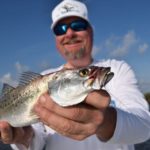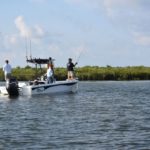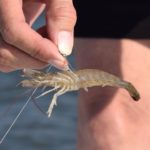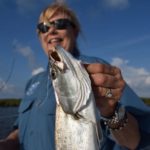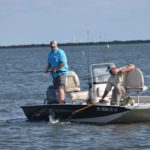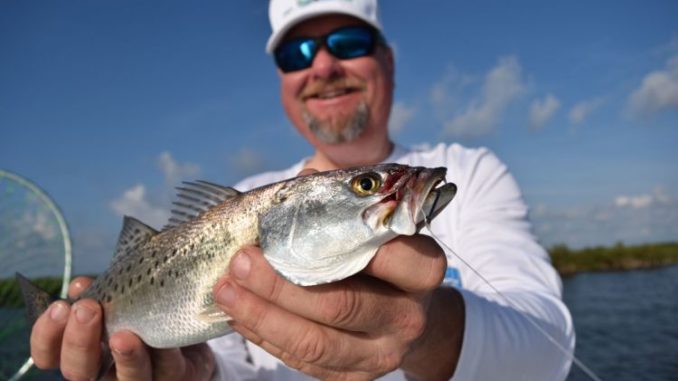
Knowing what the wind and tide are doing is critical to success at Fourchon and beyond
Fishing isn’t exactly cheap. Sure, golf might be an expensive hobby, but angling can be one of the most wallet-emptying pastimes a man can take up. From the initial investment of your boat, to gas, to jigheads and everything in between, it can get pricey in a hurry.
Oh, and don’t forget about those 50-cent-a-pop live shrimp you bought at the marina that somehow managed to expire just before you get to your fishing hole. The bottom line? In order to make all your investment worthwhile, you want to have examined all the variables beforehand, or you won’t be eating fish for supper.
For Capt. John Chauvin of Fin-tastic charters, his daily routine involves checking variables to ensure he keeps up with the beat of what’s happening with the conditions in the area so he can plan accordingly.
“I look at the wind and tide prior to going,” he said.” That’s really an important thing to do.”
Chauvin fishes out of Port Fourchon, which forces him to decide every morning if he’s going to run to Timbalier or to Grand Isle — making it that much more crucial to check the wind. Pick the wrong general area on the wind direction for the day, and you might as well be fishing in the Bering Sea.
“Fishing the backside of Timbalier on an east or southeast wind is doable,” he said. “On a west wind, it’s really hard.”
No matter which area he fishes, Chauvin said bait is the most important thing to find.
“I look for baitfish and signs of fish,” he said. “The trout and reds are going to follow the baitfish — they’re not there just to hang out. If you find baitfish, fish underneath them.”
When fishing the Timbalier side, Chauvin focuses his efforts on the downcurrent side of points, as well as the leeward sides of the coves.
As far as rigging, Chauvin throws live shrimp under a popping cork with a 2-foot leader, and he advises anglers to work their corks aggressively.
“Get some popping going on,” he said. “Trout are instinct feeders, and they want to hear that feeding sound, so they’ll go after it.”
Many times when Chauvin fishes on the Grand Isle side, he fishes hard structure, and he has specific areas that he prefers.
“I like to fish the rocks on the front side of Grand Isle, and the ones on either side of the pass,” he said. “A lot of the islands behind Grand Isle are starting to wash away, but they still have some really good islands there.”
Chauvin also fishes around a spot that is popular among people without boats in the Grand Isle area.
“(Elmer’s Island) is great this time of year when the seas allow you to get out there,” he said.
When fishing around the sand of Elmer’s, Chauvin uses a certain tactic.
“If you’re going to fish on the beach, you want to use a Carolina rig,” he said. “Fish it close to the surf early in the morning, and typically they’re going to come back to the second sandbar after 8 o’clock.”
Chauvin usually uses a ½-ounce egg sinker on his Carolina rigs.
“Some people like to go lighter, and if you don’t have a lot of wind, you can,” he said. “I like the ½-ounce because it’s easier to cast, and in a lot of the areas I fish, it works well.”
Chauvin said anglers would have to be crazy to leave the dock without live shrimp this time of year.
“I love live shrimp when I’m trying to catch a smorgasbord of fish,” he said. “I don’t find live croakers work well at just any spot; you have to fish them around the beaches and some of these rocks.
“Live shrimp are all over in the bays, so if you have to fish toward the bays due to the weather, I like to bring a lot of live shrimp.”
Many anglers in the summertime will stick their live bait either on the back of a Carolina rig or under a cork. Although that is certainly effective, Chauvin often implements a different way to present his live shrimp.
“If I’m fishing oyster beds or rock bottoms, I’ll freeline it,” he said.
Chauvin said the bite isn’t always easy to detect, but once you figure it out, it’s a deadly way to put speckled trout in the boat.
“It takes a little bit to get used to how to freeline a bait, but once you catch the first one, you get the hang of it really quickly,” he said. “You might not necessarily feel the ‘bump’ as much as you’ll watch the line go out. Sometimes, he’ll grab it, sit there, and you’ll feel a slight tug.”
There are some distinct advantages to freelining bait as opposed to other methods, according to Chauvin.
“It allows that bait to get into the rocks where the fish are holding,” he said. “If you’re fishing rocks, you don’t want to have the bait 20 feet away from where that bait would typically be sitting.”
Because there’s no weight or popping sound to impart any attractive features to the rig, having frisky live bait is a must. Chauvin also goes to great trouble to make sure he hooks the live bait in the most natural fashion — giving it the most free-swimming presentation possible.
“I like to hook the croaker behind the dorsal fin, giving it the freeness to swim as natural as possible,” he said. “It’ll get right into the nooks and crannies of the rocks where the trout are looking for them.”
Chauvin impales a live shrimp a little bit differently.
“I like to hook it about an 1/8-inch underneath the horn, and it’ll hold on really well,” he said.
Clean water is crucial this time of year, and you should lower your expectations if you don’t find it, according to Chauvin.
“You can catch them in dirty water, but your bite isn’t going to be as good,” he said. “The bite is a lot slower compared to one with clean water.”
